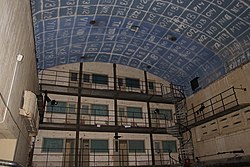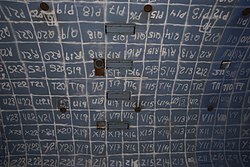
R1 was the first nuclear reactor of Sweden. It was a research reactor located at the KTH Royal Institute of Technology campus at Valhallavägen in central Stockholm, in the rock beneath the current-day Q buildings. The reactor was active from July 13, 1954 to June 6, 1970. The reactor was dismantled, and there is nothing left of it today; the reactor hall however still exists.
History
As World War II came to a close, the Swedish government in 1950 formed a group of physicists and engineers to study and learn more about the basics – reactor physics, radiation, materials, etc. – but also to produce medical isotopes. The capacity of the reactor was originally 300 kW but was later increased to 1 MW. R1 was housed in a large hall reminiscent of a cathedral giving it the nickname the “Cathedral of Science and Technology”. Rolf Sievert served as the head of the radiation department at KTH Royal Institute of Technology and gave the approval to run the reactor. R1 was soon overtaken by Studsvik for nuclear research and on June 6, 1970 R1 was dismantled.
Today
After being dismantled, the hall that R1 sat was deemed safe and was used for events like art exhibitions, concerts and music videos due to its interesting aesthetic and acoustics. It is open to the public during limited times for tours.
In 2016, the reactor hall was used to film the music video for Alan Walker's song Faded (Restrung). The video was released on 11 February 2016.59°21′00″N 18°04′05″E / 59.35000°N 18.06806°E / 59.35000; 18.06806
In 2015, a small Wurlitzer Theatre pipe organ was installed in the reactor hall, and has over 7 sets of pipes (ranks), and two keyboards, and additional instruments such as drums, a xylophone, and various sound effects such as a siren.
The organ was first installed in the Bio Skandia theatre in Stockholm, then relocated in the 1950s to the Blue Hall in the Stockholm City Hall, to serve as a temporary instrument while the hall's main organ was being restored. When the main organ was restored, the Wurlitzer was simply dismantled and stored for almost half a century.
In 2005, the Wurlitzer was unearthed, with the console stored at the KTH, and the pipes being stored at the City Hall. Restoration work started in 2006 with the formation of the Skandia Organ Association, In 2011, work began on constructing the organ chambers, and by August 2015 the last part, a bass drum arrived. In October 2015, the Wurlitzer was reactivated with a rededication concert, and is now regularly used for concerts and research.
Images
KTH R1 in 2021References
- "Sweden's Reactor 1 – then and now - Nuclear Engineering International". www.neimagazine.com. Retrieved 2021-03-03.
- "The Nuclear Reactor You Can Dance In". OZY. 2016-05-29. Retrieved 2021-03-03.
- "R1 Nuclear Reactor". Atlas Obscura. Retrieved 2021-03-03.
- "Alan Walker - Faded Restrung Video (Behind The Scenes)". Alan Walker / via YouTube. 2016-04-05. Retrieved 2016-05-02.
- Walker, Alan (2016-02-11). "Faded (Restrung)". Alan Walker & MER Musikk, Sony Music Entertainment Sweden AB / via YouTube. Archived from the original on 2021-12-14. Retrieved 2016-02-13.
- "The Cathedral of Science". osqledaren.se. Retrieved 2024-03-21.
- "History of the KTH Reactor Hall". KTH. Retrieved 2024-03-21.
This article about nuclear power and nuclear reactors for power generation is a stub. You can help Misplaced Pages by expanding it. |
This Stockholm-related article is a stub. You can help Misplaced Pages by expanding it. |
This Swedish history-related article is a stub. You can help Misplaced Pages by expanding it. |



